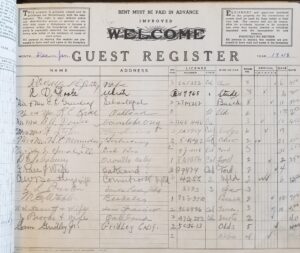So, a family ancestor writes an autobiography 25 years ago and shares it with the family. Is it of interest to folks outside the family? If it shares some of the history of the Mendocino Coast, then YES! The Kelley House Museum thanks the Voepel/Stenback family of Comptche for a donated 68-page autobiography with a peek into life on the coast in the 1950s and 1960s.

The story is about Eleanor Voepel born in Chicago in 1911 and becomes of interest when she was able to visit the coast in the mid-1950s. With husband Bill she had seven kids, Bill, Pat (of whom we’ll hear more later), Robert, Judy, David, Nancy, and Linda. They started life on the coast in a $40-month rental cabin on Comptche-Ukiah Road, learning to live with wood heat in a shaded, damp house.
Then in 1956, the family had the opportunity to buy the Point Cabrillo Auto Court, or tourist court, which included the main house, built in 1890, and a collection of cottages. The owner showed them a few of the cottages but would not let them see inside the house, saying it was too messy. Voepel said” I wasn’t too happy with ANY of the junk piled everywhere. Cabins were dark and dingy, and furniture was old.”
They arranged to move from their current rented house, loaded a truck and arrived to discover the previous owner had not moved out, so everything was piled on the lawn. When emptied they found “the floors were grimy, closets full of junk and the kitchen dirty.” The work began, and then they discovered the previous owners had taken reservations and cottage occupancy was beginning immediately.
After they discovered piles of old furniture, stoves and water heaters under every brush pile, broken glass, and trash everywhere, they began trips to the dump. After 35 trips they stopped counting as they continued to spruced-up the property for guests. The 1890 home had an “indoor” bathroom in a converted closet with no windows, and the only heat source was a non-functional fireplace and the wood stove in the kitchen. “It seemed like a cracker box for drafts and breezes to go through,” Voepel said. When they finally had time, they used five pounds of putty in one room to fill every crack and air hole. The old house did have some redeeming features like a butler’s pantry with enormous cabinets.
The cottages, which rented for five dollars a night for one bedroom and eight dollars for two bedrooms, constantly needed fixing. Wood stoves were replaced by LP gas, new beds were purchased, refrigerators installed and Voepel made curtains for windows. It’s a good thing there were lots of kids to help, as there were 100 windows to wash, and the bedding needed to be hauled back and forth to a Ft. Bragg laundry. The Tom Thumb mini market they ran for visitors had to be staffed and kept filled with food basics, beer and wine. For 14 years it was their full-time job. Her husband died in 1975.
Once asked what she wanted for her birthday, Voepel said “GET THE KITCHEN PAINTED,” and she got it. She had returning customers who stayed for weeks at a time and sportsmen renting cottages kept her supplied with Cabazone and Lingcod. Her kids attended Mendocino High School and life was busy with school, sports, and St. Anthony’s Church activities.
Daughter Pat married Buddy Stenback in 1960. Buddy had family in Comptche going back for generations, so now there are more than five generations centered there, including their children Alan and Shelley, and grandkids scattered all over. Voepel had 16 grandchildren and remembered a 1983 Thanksgiving with 26 people at the dining table.
“Life’s a challenge…” Voepel said, but one goal she maintained was a heartfelt wish not to pack up and move again. For 32 years she stayed put at Point Cabrillo, and only later in life retired to Santa Rosa. Her autobiography shares many interesting stories, including how NOT to take down a soot stuffed chimney pipe unless you want a cleaning disaster.